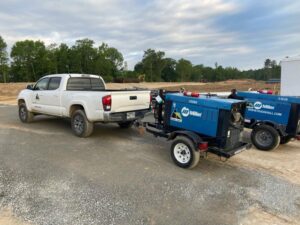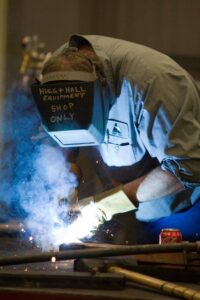
Choosing The Right Welder
 Defining your welding process should be the first step taken when deciding on a welder. The welding process you choose will depend on factors such as the type of thickness of your materials, the environmental conditions you will be working in, your skill level, and your time constraints.
Defining your welding process should be the first step taken when deciding on a welder. The welding process you choose will depend on factors such as the type of thickness of your materials, the environmental conditions you will be working in, your skill level, and your time constraints.
In our article below, we explain the four most popular welders:
MIG Welding
One of the easiest welding processes to learn is MIG (metal inert gas) welding, aka gas metal arc welding (GMAW). A MIG welder uses a continuously fed solid wire electrode that melts to bond two base materials together. An inert shielding gas (carbon dioxide and argon/CO2 blends are the most common) contained in a separate bottle is also passed through the welder to prevent exposure of the molten weld pool to airborne contaminants.
As this technique melts an electrode to act as a filler material, it is often used for welding together various metals and alloys (steel, stainless steel, aluminum alloys) ranging from extremely thin (starting at 24-gauge) to 1/2-inch thick.
Before using a MIG welder, on many models you will need to set the voltage and the wire feed speed. These models include a chart with suggested voltage settings based on material type and thickness. Other models adjust the settings automatically after a series of dial inputs.
MIG welders generally have a duty cycle of 30 percent to 50 percent, so you can expect three to five minutes of continuous arc welding out of every ten minutes.
Flux-cored Arc Welding (FCAW)
If your next welding project involves both heavy materials and the possibility of working outdoors, you might want to consider a flux-cored arc welder (FCAW) for the job. It uses a similar power supply as a MIG welder (in some cases, the same one) as well as a continuous wire feed, but it does not use an external shielding gas. Instead, a flux compound within the hollow electrode wire reacts with the welding arc to generate the gas that protects the weld pool from oxidation. This shielding process makes FCAW appropriate for outdoor welding work, where wind might otherwise interfere with the bonding process. If needed, additional shielding can be integrated with an external gas tank.
as a MIG welder (in some cases, the same one) as well as a continuous wire feed, but it does not use an external shielding gas. Instead, a flux compound within the hollow electrode wire reacts with the welding arc to generate the gas that protects the weld pool from oxidation. This shielding process makes FCAW appropriate for outdoor welding work, where wind might otherwise interfere with the bonding process. If needed, additional shielding can be integrated with an external gas tank.
With the proper filler metal and flux composition, this type of welding works well for applications involving carbon steel, stainless steel and low-alloy steels. Non-ferrous metals such as aluminum, brass, gold and nickel will not work with this process. Thanks to its flux compound, FCAW is more tolerant of base metal contaminated by dirt, rust or paint.
Duty cycle on FCAW is generally about 40 percent, so you can expect three to four minutes of operation out of every ten minutes.
TIG Welding
Similar to MIG welding in its use of an inert gas for shielding, TIG (Tungsten Inert Gas) welding, aka gas tungsten arc welding (GTAW), differs in its use of a non-consumable tungsten electrode. Unlike the electrode in a MIG setup, this one does not burn up. The tungsten acts as a torch that melts the metal or a filler material. This makes TIG a practical choice for applications that require a clean appearance. TIG welding is also valued in tight quarters because of the lack of smoke, fumes or sparks.
Because TIG is applicable to both ferrous metals and non-ferrous metals such as aluminum, it is used often in industries that require high-quality welds, such as aerospace and ship-fitting, as well as in the military. Thanks to its ability to operate at low amperages, it is also used for welding extremely thin materials such as foils and lightweight metal sheets. The only metal TIG is not suitable for is cast iron.
The increase in quality comes with a long learning curve. Unlike MIG welding, which can be picked up rather quickly, it takes time to learn the nuances of TIG to avoid overheating and cracking the metal being bonded. TIG also requires a constant current power source. AC should be used when welding aluminum.
Stick Welding
One of the most common arc welding techniques, shielded metal arc welding, or SMAW, also called “stick” welding, uses a flux-coated electrode (the stick) to form the weld. Similar to FCAW, electricity passing through the electrode reacts with a flux compound to generate the necessary shielding gas. This gives the welder a big advantage when working on projects in unfavorable environments such as wind or rain.
Portability and lower sensitivity to dirt or paint at the weld point makes stick welders a popular option for use in remote locations. This type of welding is practical only on steel, stainless steel and cast iron.
Downsides of stick welding include the high skill level required and associated downtime. Electrode sticks can be only so long, and work must be stopped to replace them once they are consumed. In addition to limitations with thinner metals, stick welding is also slow and requires slag to be chipped away after welding is complete. Common applications include pipelines, farm machinery and even underwater welding.
Duty cycle on stick welding is generally less than 25 percent, so you can attain roughly 2.5 minutes of welding operation out of every ten minutes. A DC/AC welder power supply is best.
You should always have the proper training and experience necessary to undertake any welding techniques and procedures. Also, you should adhere to all manufacturer specifications regarding the use and operation of any welding equipment and/or accessories that you are employing for your job.
For more information on the availability of welders and welding accessories for your next project, contact a Hugg & Hall branch near you or browse our inventory here.
Back to News
Subscribe and unlock cutting-edge equipment insights, trends and tips!
Subscribe